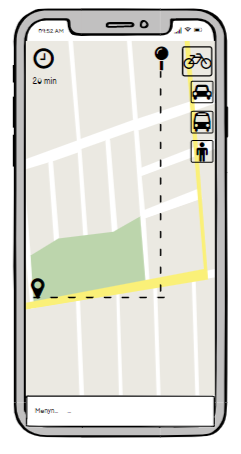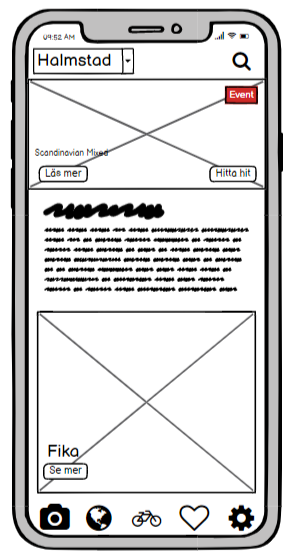Destination Halmstad
Destination Halmstad
Overview
During this brief the focus was smart societies, which are communities that use technology to improve the quality of life for its citizens. Our designteam was given the brief "From center to Tylösand" which required us to develop Halmstad as an event destination both now and in the future. We achived our goals through Figma and Balsamique.
Methodology
During our first meeting with Destination Halmstad, we learned about their plans for the upcoming Volvo Cars Scandinavian Mixed event. Our contact person, Johnny, emphasized the importance of focusing on this event to attract more visitors to Halmstad.
As we delved deeper into the brief, we realized its broad scope and decided to limit ourselves to what Destination Halmstad wanted to convey and what we could contribute. To gain a better understanding of the customer's journey, we performed a service safari, which involved documenting our observations and discussing them as a group. While interviews initially seemed like a useful method for data collection, we ultimately found that they did not provide us with important information. Therefore, we decided to use a survey to gather additional perspectives on which modes of transportation Tylösand visitors primarily prefer to use and the behavioral patterns for why they use that mode of transportation.
In addition to these methods, we also learned how to perform a workshop and how to proceed and what you get out of it. Our group conducted our first workshop, which we prepared for by doing research on the method. We invited stakeholders from Destination Halmstad, who have knowledge of Halmstad as a host city, and stakeholders from HighFive, who have experience working at an innovative company, to participate.
Results
Throughout the design process, we used a variety of service methods to achieve our final result. This included adapting our methods to fit the unique challenges presented by the upcoming golf tournament, such as the lack of previous data and a planned plan on how the event will be performed. By working closely with project planning and meeting with the customer, we were able to come up with different methods that we could apply to this project and which delimitations we should make.
Reflections
This project was the most educational one I have taken so far. I learned how service methods can be applied in a design process and how to adapt to unique challenges that arise during an ongoing event. The research phase took up most of our time, which was different from previous projects where prototyping or programming had been more time-consuming. By reading through articles and doing desktop research, we were able to plan and structure our design process effectively. We realized that traditional data collection methods did not work and that we needed to focus on service-oriented methods instead. This made us view the design process from a different perspective and use more service-centered methods than traditional ones. Overall, this project taught me valuable skills that I can apply to future projects.
Early Sketch and Prototype
Role as Head of Research
As the head of research within my designteam, I participated in various phases of the design process, including service safaris, survey data collection, and a workshop with stakeholders. I also helped to analyze the data and insights gathered from these methods to inform our design decisions.
During the initial phase of the project, my focus was gaining a better understanding of Destination Halmstad and how it operates as the host city for various events, particularly the upcoming Volvo Cars Scandinavian Mixed event. To achieve this, I created a stakeholder map to get a clearer picture of which actors are directly involved in the event and which are indirectly affected by it. Additionally, I researched Smart Communities, which is the course focus, by reading various articles. I found that many organizers of larger events promote the community's existing transport services and encourage their visitors to choose this type of service over privately owned cars. The research I conducted helped our group progress with the design process.
Finished protoype



